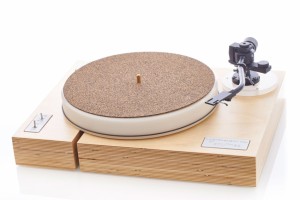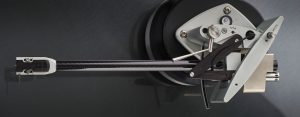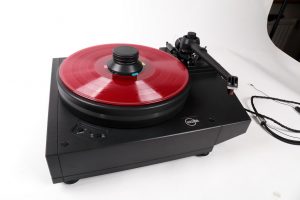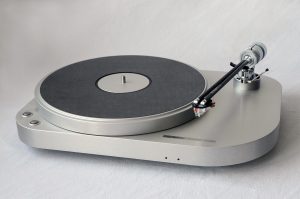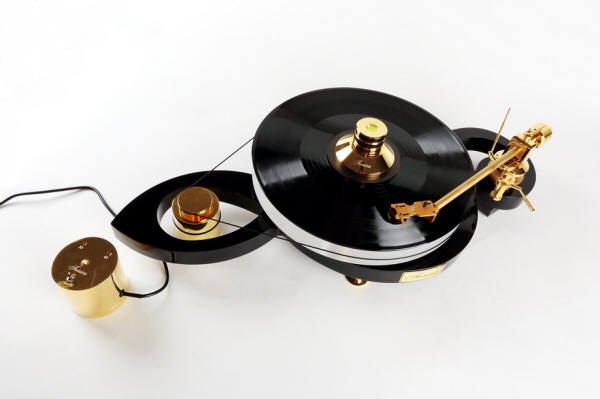
The turntable is a relatively simple mechanical design. Its task is to spin the platter with a vinyl disc in an appropriate manner, i.e. at a predetermined speed. The rotational speed should be perfectly stable over time and no external disturbances, including vibration and noise, should be transferred to the platter.
In the real world, it is as it is, i.e. despite well over a hundred years since the creation of the first flat discs and the turntables to spin them, we still face the same—by now clearly identified—problems: rotational speed stability and resistance to vibration and noise.
The stability, similarly as vibration and noise, is dependent on a system that includes the main bearing, the platter and the drive system (the motor with transmission, or a direct-disc motor), as well as the mechanical properties of the base.
Over the years, vibration and noise reduction had been realized in two ways: either via decoupling the platter with the arm from the base, or by minimizing vibration in the base itself (and the platter). The latter method primarily relies on proper material selection and usually involves damping the vibration through a mass loaded design.
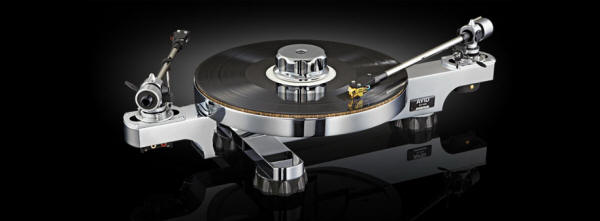
There is, however, another view on that matter. I could see it as plain as a pikestaff when I was once reviewing the Kuzma Stabi S. Its designer, Franc Kuzma, followed the assumption that in order to minimize the vibration of the base one should minimize the base itself (you can find the review HERE). The Stabi S simply consists of two cylinders connected at the right angle. The effects obtained with this simple trick are very interesting. It is then no wonder that other manufacturers came up with their own versions of this solution. The best known is perhaps the Ingenium from the British company Avid HiFi. A refined variant of the idea is a design from Cardas called the SpJ La Luce, with the Pro-Ject RPM RP-1.3 and Elemental at the other end of the price list.
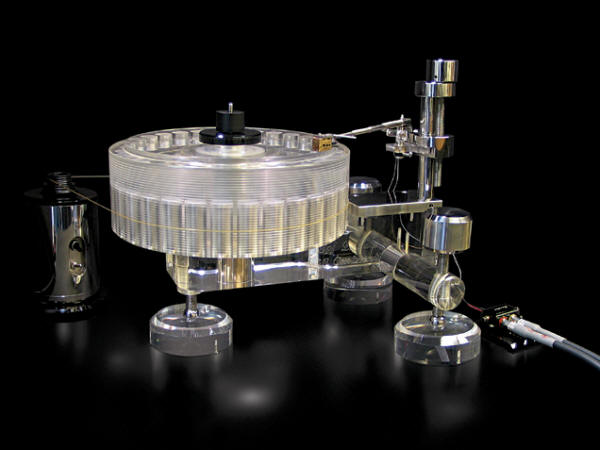
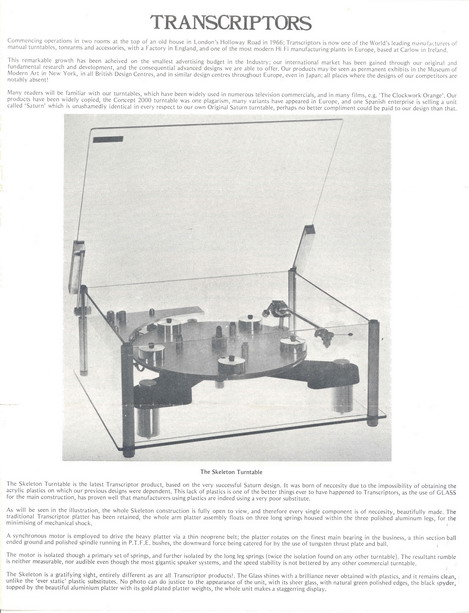
The very idea is of course much older and its most famous, thus far, example is a 1973 turntable from Transcriptors called the Skeleton. Designed by David Gammon, it was produced for a limited period of time, until 1977. It showed, however, that there can be a "third way" in designing a stable base that does not reduce vibration by accumulating it in its high mass.
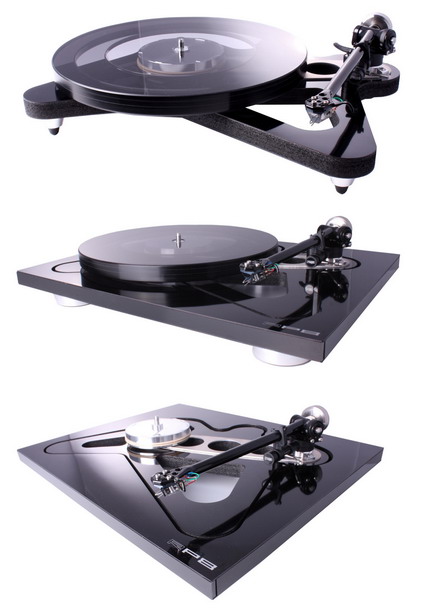
The RP-8 from Rega was a direct reference to this design solution. Brilliant in its simplicity, the idea was to propose a radically new and different approach to the mechanics, without alienating the music lovers with an unusual shape. The base thus consisted of two parts: a proper base, with the arm, platter bearing and motor attached to it, and an auxiliary base to mask the unusual shape of the base proper. After assembly, the turntable looks like a classic Rega, yet it benefits of the advantages of minimized vibrating mass.
When I first saw the F-901 Violin from Fonica, I mentally linked it with these efforts. And even when I later saw the information that aesthetic considerations were the main reason for equipping the turntable with a small treble-clef shaped acrylic base, I could not fully let go of that intrusive thought. Regardless of the reasons, the end result remains the same: minimizing the vibration area.
The turntable was first presented at the High End 2014 show in Munich. The room where it was playing was visited by Dirk Räke from Transrotor, who then invited Mr. Radosław Łodziato, Fonica's owner and the man who rescued it from oblivion, to Transrotor's room. There he introduced him to the chief engineer of Transrotor, Mr. Gerd Weichler. Mr. Weichler said that he knew Fonica very well and that he had visited its manufacturing plant in Lodz in the 1990s, where he saw the turntables that were manufactured by the Polish company for Thorens. "I really felt as if I touched history," says Mr. Łodziato.
And so we have gone full circle. In the early 1970s, Transrotor was a Germany distributor of Transcriptors turntables from Mr. John Michell. Shortly afterwards, in 1973, Mr. Jochen Räke, Dirk's father, asked Michell to manufacture for him the turntable components that he wanted to assemble and sell in Germany. Since it turned out that the production in Germany was going better, even though it was more expensive, Mr. Räke took up the manufacturing of Transcriptors. Soon he founded his own company, Transrotor. And so we have gone from the Skeleton from 1973, through the founding of Transrotor in the same year, to the Fonica Violin that repeats John Michell's idea, albeit in a modified form.
A few simple words from…
ANDRZEJ SKOCZYLAS | designer

The core of Audio Fonica A.D. 2014: Mr. Radosław Łodziato (right), company's owner, and Mr. Andrzej Skoczylas, designer. The picture was taken during the Audio Show 2014 in Warsaw.
Well, where should I start? Radek (Mr. Łodziato – ed. note) kept on repeating from the beginning that we need to come up with our own tonearm. That he wants to have everything manufactured in-house by Fonica. We started the work in our office in the back of Fonica's production plant and for over half a year we drew a lot of sketches in SolidWorks and on paper, we machined various parts on our lathes, assembled them and whatever was not acceptable in auditions ended up in the trash bin. And so on, over and over. Radek wanted an elegant-looking arm that would be as adjustable as possible yet free of unnecessary parts and components that might have any adverse effect on the whole design. In the meantime, we would disassemble and analyze various arms from other manufacturers, including Rega or SME. Once we knew what it should sound like with our '800' that we were using for the auditions, and what kind of materials needed to be used, three versions remained on the battlefield. After two more months of testing the prototypes we finally chose one of them. What was most amazing was that once we applied finish coatings (e.g. anodizing), the arm turned out to sound different again. There was no other choice than to go back to the previous prototypes, apply the same final finish to all of them and only then to pick up the arm that—now in version no. 3—would be manufactured by our company.
And the Violin? It is the result of the need to be innovative and to stand out from other turntables. I am glad that the turntable came out very good sonically, not to mention that it is eye catching and can be the pride of any audiophile system. In the words of Mr. Onufry Zagłoba: "not to be boastful, ‘twas me who did it."
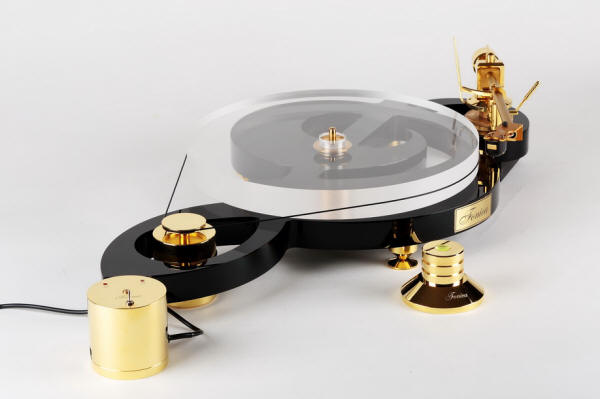
The F901's design draws on the best experiences of our previous models. In its construction we used expensive black acrylic, hand polished to a high gloss finish. The primary material is expensive brass, instead of steel and aluminum, because of its elegance as well as vibration damping qualities resulting from its density. All brass components are coated with gold. The headshell and arm tube is made of scratch-resistant quality anodized aluminum. Since the anodized surface does not conduct electricity, it provides special sonic characteristics.
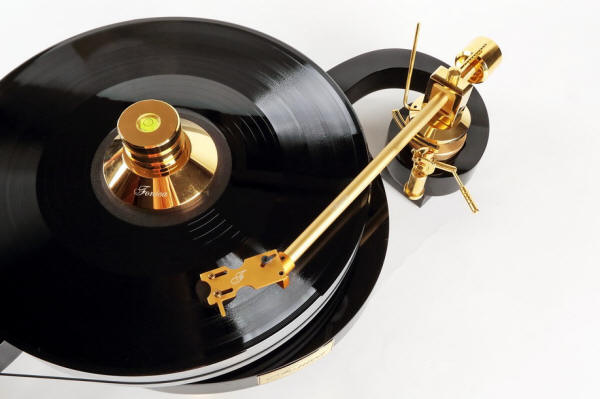
The system of three brass spikes mounted to the turntable base with the help of rubber absorbers provides additional decoupling from the ground. The high quality sliding bearing ensures whisper-quiet operation, vibration reduction and durability. The outer part that supports the platter rests on the ball made of Zirconium dioxide, whose strength is comparable to diamond.
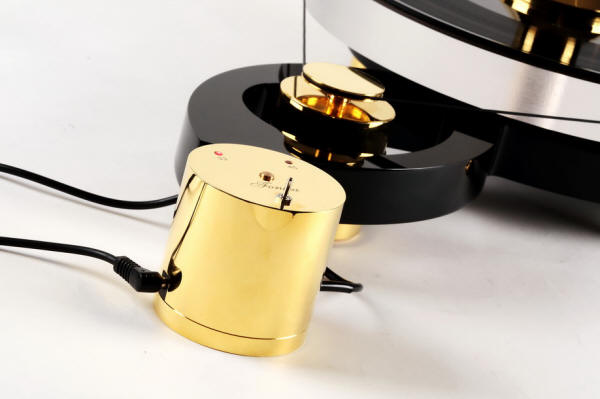
The motor is controlled by a dedicated generator that features a modern high-precision circuit to provide an ideal rotational speed. By using a processor with a quartz oscillator clock it was possible to achieve a very precise rotational speed regulation, which has a decisive influence on the listening experience quality. The speedbox design, with its repeated AC to DC and back to AC conversion, additionally provides total protection from any mains power noise or interference and allows the turntable to be easily operated in both 50Hz and 60Hz environments.
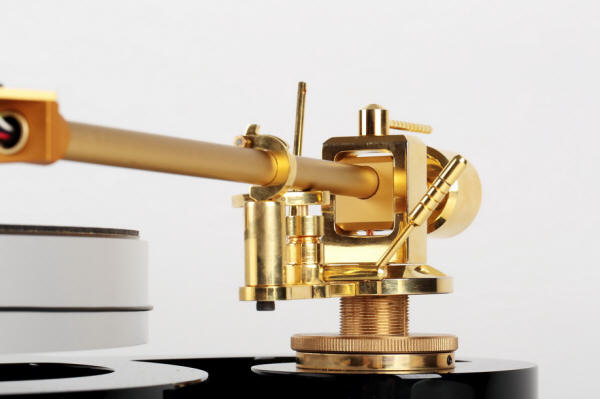
The F-901 turntable uses the F-03 rev3 tonearm designed and manufactured in-house by Fonica. It is the third version of this arm.
The F-03 is a "no compromise" design. We use the least possible amount of plastic materials. Hence, the arm is made entirely of brass and extremely hard anodized aluminum. In the process of anodizing, the arm surface hardness reaches nearly 60 Rockwell. Moreover, the arm offers multiple adjustment options for the sake of convenience and full customer satisfaction of the most demanding audiophiles. Internal wiring between the arm and the output connectors is made of high quality materials.
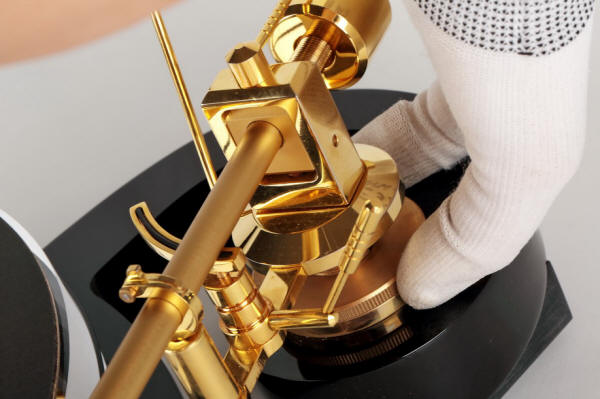
The arm differs from the previous versions in its pivot and bearing design. The changes made it possible to increase its overall stiffness, which contributed to the improvement in geometry and provided about 100% greater height adjustment range. It allows the arm to be equipped with the most demanding phone cartridges.
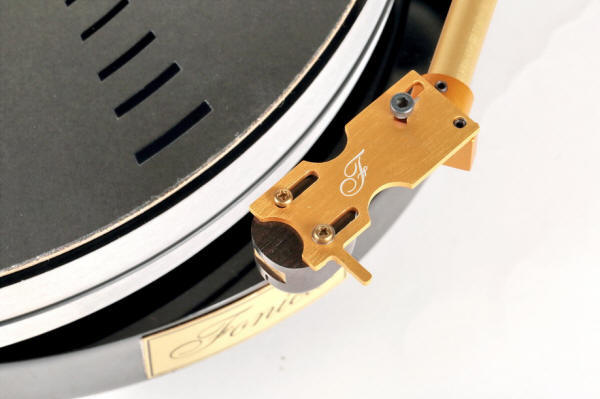
Additionally, version 3 of the arm sports an additional copper shielding inside the tube arm, which brings even more positive influence on the sound.
The turntable is packaged in a wooden box lined with high-quality foam.
SOUND
Albums auditioned during this review
• Breakout, NOL, Polskie Nagrania “Muza” SX 1300, LP (1976).
• Brendan Perry, Ark, The End Records | Cooking Vinyl | Vinyl 180 VIN180LP040, 2 x 180 g LP (2011).
• Chico Hamilton Quintet, Chico Hamilton Quintet feat. Buddy Collette, Pacific Jazz Records 1209, LP (1955).
• Clifford Brown and Max Roach, Study in Brown, EmArcy Records/Universal Music Japan UCJU-9072, 200 g LP (1955/2007).
• Czesław Niemen & Akwarele, Sukces, Polskie Nagrania “Muza”/Polskie Nagrania XL 0390, 180 g LP (1967/2014).
• Czesław Niemen, Katharsis, Polskie Nagrania “Muza”, SX 1262, LP (1976).
• Czesław Niemen, Postscriptum, Polskie Nagrania “Muza”, SX 1876, LP (1980).
• Frank Sinatra, The Voice, Columbia/Classic RecordsCL 743, Quiex SV-P, “50th Anniversary”, 180 g LP (1955/2005).
• Freddie Hubbard, Open Sesame, Blue Note/Classic Records BT4040, Quiex SV-P, 200 g LP (1960/1999).
• John Coltrane, Giant Steps, Atlantic/Rhino, R1 512581, "Atlantic 45 RPM Master Series", 2 x 180, 45 rpm (1960/2008).
• Morton Subotnick, The Wild Bull, Karlecords KR018, “Limited Edition of 500”, 180 g LP (2014).
• Thelonious Monk, Solo, Columbia/Music On Vinyl MOVLP843, “Classic Album”, 180 g LP (1965/2014).
The materials as well as technical solutions used for the construction of the base are something of a "foundation" that builds up the sound of the whole turntable. They set the framework in which we will later operate. The arm brings in a certain direction and the cartridge completes the whole, and helps to bring out everything that was provided by the base and "refined" by the arm.
Hence, I have a deep conviction concerning the sonic properties of the specific materials used in the design. Turntables with wood, metal, glass components behave all different, as do those with acrylic parts. While combining different materials in a sandwich design gives something else still, it usually results in averaging the characteristics of the individual components of the “sandwich.”
Acrylic has its own very distinctive "expression." On the one hand, it slightly dampens the sound, rounding its attack and calming down transients, and on the other it emphasizes the upper midrange, offering quite good selectivity. Audio designers use these features in various ways, bringing out one or the other. They all operate within the same limits, though.
The Violin is almost exemplary at showing one of the possibilities, which is to make the sound denser and warmer. At the same time, it does not withdraw the treble any more than necessary. The latter seems to be almost on par with the rest of the frequency range, except that it is sweet, dense and sonorous. But its sonority results from weight and depth rather than fast attack.
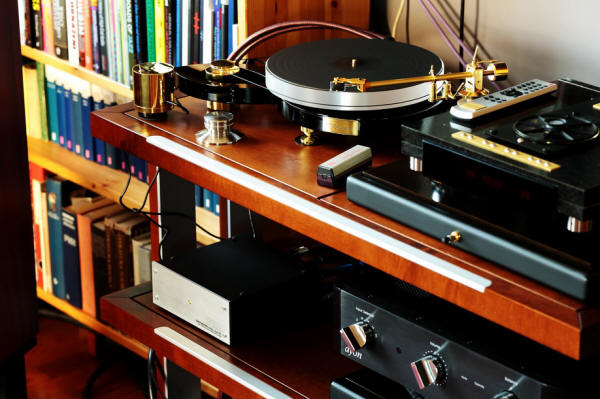
That is why the sound is more reminiscent of what is offered by Scheu Analog in the Classic than, for example, the Transrotor Zet 1 or the Thales TTC-Compact. It would be closer to the Avid Acutus SP and Goldenote Bellavista Signature than to the Dr. Feickert Analogue Woodpecker. Actually, if I had to choose a design that would sound most uniformly similar to the Polish "treble clef", it would be the Viella AMG V12, a turntable made largely of aluminum.
This sound can be described in but a few words, and then differentiated further within their scope. Each record has its own depth and "weight." With the Viola, there are no light and trivial discs. It is an obvious homogenizing of the presentation, but what kind of homogenizing it is! With the Fonica, there are no sharp and bright sounding discs. I have no doubt that it means bringing the records to a similar level. At the same time, however, it gives an incredible comfort in listening to even old, technologically inferior discs. Everything sounds smooth and nice. And last but not least, there are no dry sounding discs with the Polish turntable. There is always a strong lower midrange and upper bass. And the whole presentation is based on a deep foundation that has a pretty tonal quality.
As I said before, despite a clear warming of the sound, the treble is not recessed. The difference between the treble and the warm midrange is fascinatingly audible wherever it is important musically, as in the cymbal crashes opening Clifford Brown's album Study in Brown. Or—perhaps even more clearly—at the beginning of the title track from Czesław Niemen's album Catharsis. The cymbals are beautiful because their sound is strong and dense. Not only here, because they sound exactly the same on Freddy Hubbard's Open Sesame and Coltrane's Giant Steps, but in the two previous cases the result was truly electrifying.
Although the attack is smooth and rounded and the sound warm, I was not prepared for how much the Violin emphasizes the recordings' "dark side" (in the sense of "not bright"). On NOL from the Polish band Breakout, as well as on the original pressing of Chico Hamilton Quintet from 1955 the sound was dark, dense, saturated and extremely pleasant.
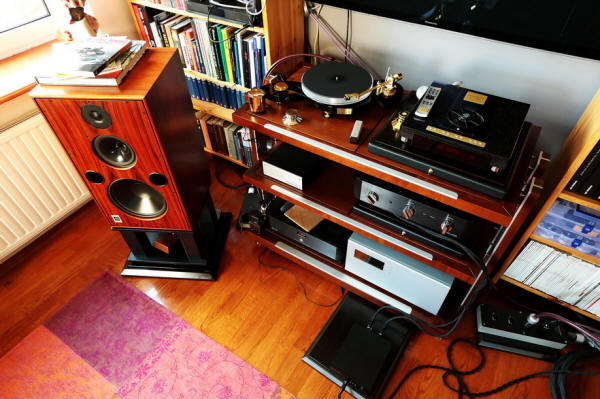
At the same time, I did not feel a lack of anything particular. Although it needs to be said that this is not an especially selective or extremely detailed presentation. It favors big planes rather than detail; the overall picture over micro-events. Nevertheless, the interplay between the musicians during the concert of Chico Hamilton with his friends, which took place on August 4th, 1955, in the Harry Rubin's Strollers club was almost tangible in its band work, harmony and feeling. The recording was made with two Western Electric 640AA microphones, one of them positioned above the whole band and the other above the cello, with the help of the Altec 21C microphone mounted to the double bass. Jim Hall's guitar was coupled to the guitar amp and mixing console at the same time. This simple recording method resulted in a dark sound, due to a limited frequency range of the microphones and tape recorder. But the sound is incredibly dense and natural. Interestingly, the aforementioned Breakout album, similarly dark and limited in the top end, also sounded very nice. Of course, it lacked an equally good insight into the "event", but the result was at least satisfactory.
Conclusion
Thanks to all these qualities, the Violin is a very versatile audio source. It offers a kind of "absolution" to the vinyl discs that are played back on it. Music For Vinyl releases, very clean but somewhat drier than the originals prepared from analog master tapes, sounded darker and denser. The new vinyl reissue of Czesław Niemen's album Success, not particularly convincing (just like the vinyl reissue of his Dziwny jest ten świat…), sounded quite vicious and in parts even interesting.
In turn, quality produced records sounded just brilliant. The sound depth was exceptional with each one of them. The same with electronica. Morton Subotnick's album The Wild Bull, difficult to play back properly, sounded fascinating.
The turntable does not overexpose the recordings and is not particularly selective. It corrects the sound in a concrete, easily perceptible way. However, it does it with grace that results from the kind of "it is good that way" conviction. Pops are not very audible, but they do exist and are not clearly separated from the music itself. Well, even such a cool design is not without its limitations.
DESIGN
The Fonica Violin can be discussed as an example of industrial design. There are good reasons for that, both because of the manufacturer and customers' reactions. The manufacturer wanted to have in its product lineup a turntable that would have appealing looks and could complement the aesthetic appearance of the room interior. Hence, instead of hiding the frame in a classic base, as Rega did in the RP-08, Fonica brought it to light. Whereas Rega wanted to offer something new without turning away the more conservative customers, Fonica went the other way round and decided to attract the new ones.
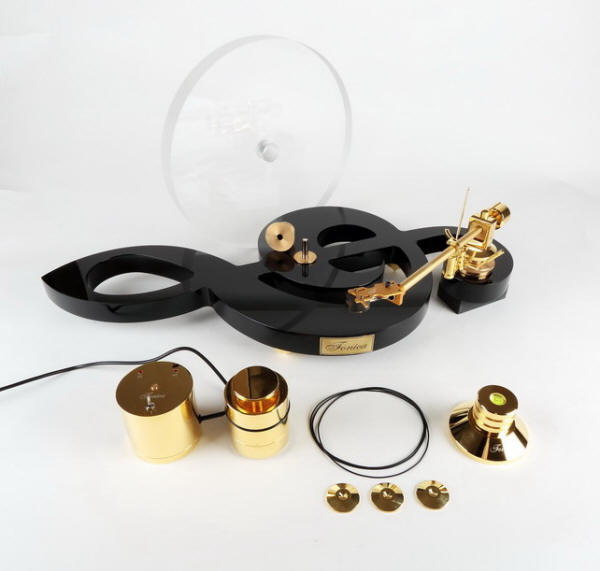
The base of the F-901 has the shape of a treble clef. The tonearm is mounted in its upper part, where it curves up to form the "head." The main bearing is located in the center, at the line intersection. The motor, in turn, has found its home in the lower swirl "window". Hence the motor, the platter bearing and the arm are located along the same line.
The base is made of polished black acrylic. It rests on three brass, gold-plated spikes, and those in turn are supported by small discs. The spikes are tightly pushed into the holes in the base bottom. Rubber absorber rings are used to decouple the turntable from the ground to some extent. The feet are positioned to form a triangle, in such a way that the point of intersection of the perpendicular bisectors to the sides of the triangle coincides with the center of gravity of the whole turntable.
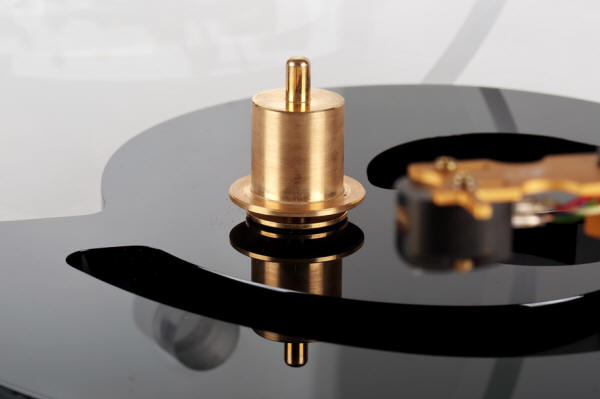
The steel spindle sits on the ball made of Zirconium dioxide, whose strength is comparable to that of diamond. The spindle features of a small cylinder with a "flange" to support the platter. The platter itself is made of glass, with a thick felt mat on the top. A heavy record clamp is made of gold plated brass and was previously available as an optional accessory. I do not like this type of mats and I only use cork mats from Pathe Wings or the professional TU-800EX Improved Version mat from Harmonix.
The synchronous AC motor is housed in a heavy brass enclosure. It features a large pulley mounted on its axle. It drives the platter by means of a long round rubber belt.
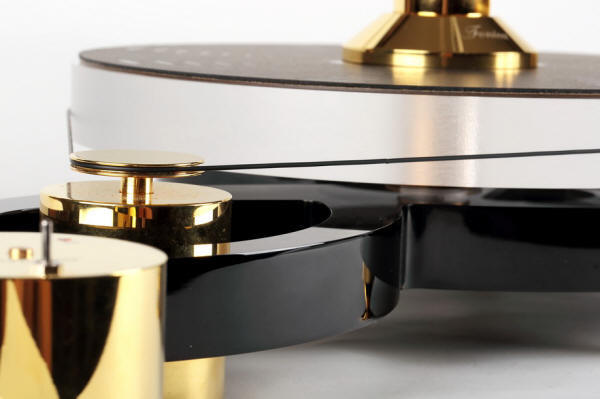
The motor is powered from an 18.8 V AC external controller, also housed in a cylinder enclosure. The umbilical cord that couples the two looks very ordinary and is the only part of the whole design I would suggest spending some time on. The controller sports a small on/off toggle switch, a push button and two LEDs. The latter indicate the speed selected by the button: 33 1/3 rpm or 45 rpm. The motor rests on tiny rubber footers, while the controller sits directly on the ground. It might be worth decoupling the latter in some way.
The arm is Fonica's own design. Currently into its third version, it features gold-plated brass and aluminum components. The arm tube is made of hard anodized aluminum with the surface hardness close to 60 Rockwell. The arm is of a gimbaled type and the gimbal bearing sports brass components. Overhang is adjusted by tilting the headshell, rather than pulling the whole arm. VTA adjustment is by means of loosening the screws locking the column and turning a knurled nut.
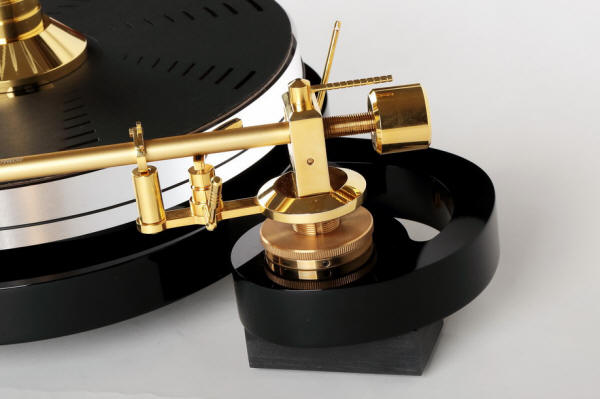
The tonearm differs from the previous versions in its pivot and bearing design. The improvements made it possible to increase its overall stiffness which contributed to the improvement in geometry and provided about 100% greater height adjustment range. It allows the arm to be equipped with the most demanding phone cartridges.
The third version of the arm features an additional copper shielding inside the arm tube. The RCA output connectors are located at the bottom of a heavy block. Anti-skating is a classic affair, with the line and sinker.
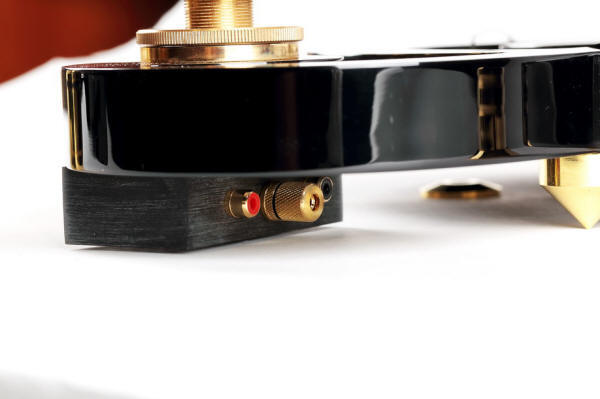
Specifications (according to the manufacturer)
Power Consumption [W]: 13.3
Inverter Voltage [V AC]: 18 V
Tonearm Length [mm]: 228.6
Tonearm Effective Mass [g]: 12
Overhang: 18.14 mm
Signal/Noise Ratio [dB]: -80
Tonearm Shape: straight
Belt Drive: YES
Platter Diameter [mm] 298
Speed [rpm]: 33 and 45
Dimensions [mm]: 570 x 340 x 142 mm
Weight [kg] 10.1 kg
Price (in Europe): 5,500 Euro (including VAT)
AUDIO-FONICA
ul. Rewolucji 1905 r. 82
90-223 Łódź | Poland
[email protected]
http://fonicamusic.com
MADE IN POLAND
Text and images by Wojciech Pacuła
Translation by Andrzej Dziadowiec










